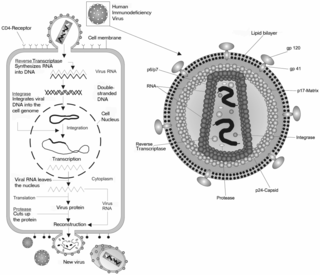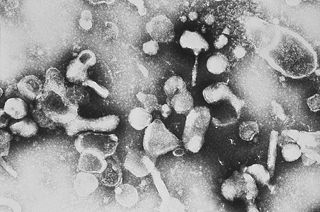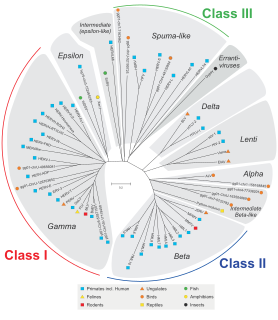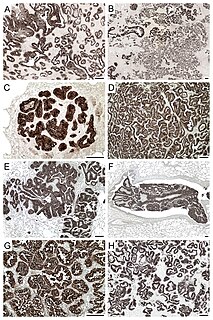Related Research Articles

A retrovirus is a type of virus that inserts a DNA copy of its RNA genome into the DNA of a host cell that it invades, thus changing the genome of that cell. Once inside the host cell's cytoplasm, the virus uses its own reverse transcriptase enzyme to produce DNA from its RNA genome, the reverse of the usual pattern, thus retro (backwards). The new DNA is then incorporated into the host cell genome by an integrase enzyme, at which point the retroviral DNA is referred to as a provirus. The host cell then treats the viral DNA as part of its own genome, transcribing and translating the viral genes along with the cell's own genes, producing the proteins required to assemble new copies of the virus.
Phylogeography is the study of the historical processes that may be responsible for the past to present geographic distributions of genealogical lineages. This is accomplished by considering the geographic distribution of individuals in light of genetics, particularly population genetics.

A living fossil is an extant taxon that cosmetically resembles related species known only from the fossil record. To be considered a living fossil, the fossil species must be old relative to the time of origin of the extant clade. Living fossils commonly are of species-poor lineages, but they need not be. While the body plan of a living fossil remains superficially similar, it is never the same species as the remote relatives it resembles, because genetic drift would inevitably change its chromosomal structure.

Simian immunodeficiency virus (SIV) is a species of retrovirus that cause persistent infections in at least 45 species of African non-human primates. Based on analysis of strains found in four species of monkeys from Bioko Island, which was isolated from the mainland by rising sea levels about 11,000 years ago, it has been concluded that SIV has been present in monkeys and apes for at least 32,000 years, and probably much longer.
Mouse mammary tumor virus (MMTV) is a milk-transmitted retrovirus like the HTL viruses, HI viruses, and BLV. It belongs to the genus Betaretrovirus. MMTV was formerly known as Bittner virus, and previously the "milk factor", referring to the extra-chromosomal vertical transmission of murine breast cancer by adoptive nursing, demonstrated in 1936, by John Joseph Bittner while working at the Jackson Laboratory in Bar Harbor, Maine. Bittner established the theory that a cancerous agent, or "milk factor", could be transmitted by cancerous mothers to young mice from a virus in their mother's milk. The majority of mammary tumors in mice are caused by mouse mammary tumor virus.
In biology and genetic genealogy, the most recent common ancestor (MRCA), also known as the last common ancestor (LCA) or concestor, of a set of organisms is the most recent individual from which all the organisms of the set are descended. The term is also used in reference to the ancestry of groups of genes (haplotypes) rather than organisms.

Tripartite motif-containing protein 5 also known as RING finger protein 88 is a protein that in humans is encoded by the TRIM5 gene. The alpha isoform of this protein, TRIM5α, is a retrovirus restriction factor, which mediates species-specific, early block to retrovirus infection.

Gammaretrovirus is a genus in the Retroviridae family. Example species are the murine leukemia virus and the feline leukemia virus. They cause various sarcomas, leukemias and immune deficiencies in mammals, reptiles and birds.

Endogenous retroviruses (ERVs) are endogenous viral elements in the genome that closely resemble and can be derived from retroviruses. They are abundant in the genomes of jawed vertebrates, and they comprise up to 5–8% of the human genome.

Jaagsiekte sheep retrovirus (JSRV) is a betaretrovirus which is the causative agent of a contagious lung cancer in sheep, called ovine pulmonary adenocarcinoma.
Simian foamy virus (SFV) is a species of the genus Spumavirus that belongs to the family of Retroviridae. It has been identified in a wide variety of primates, including prosimians, New World and Old World monkeys, as well as apes, and each species has been shown to harbor a unique (species-specific) strain of SFV, including African green monkeys, baboons, macaques, and chimpanzees. As it is related to the more well-known retrovirus human immunodeficiency virus (HIV), its discovery in primates has led to some speculation that HIV may have been spread to the human species in Africa through contact with blood from apes, monkeys, and other primates, most likely through bushmeat-hunting practices.

HERV-R_7q21.2 provirus ancestral envelope (Env) polyprotein is a protein that in humans is encoded by the ERV3 gene.
Koala retrovirus (KoRV) is a retrovirus that is present in many populations of koalas. It has been implicated as the agent of koala immune deficiency syndrome (KIDS), an AIDS-like immunodeficiency that leaves infected koalas more susceptible to infectious disease and cancers. The virus is thought to be a recently introduced exogenous virus that is also integrating into the koala genome. Thus the virus can transmit both horizontally and vertically. The horizontal modes of transmission are not well defined but are thought to require close contact.

The human T-lymphotropic virus, human T-cell lymphotropic virus, or human T-cell leukemia-lymphoma virus (HTLV) family of viruses are a group of human retroviruses that are known to cause a type of cancer called adult T-cell leukemia/lymphoma and a demyelinating disease called HTLV-1 associated myelopathy/tropical spastic paraparesis (HAM/TSP). The HTLVs belong to a larger group of primate T-lymphotropic viruses (PTLVs). Members of this family that infect humans are called HTLVs, and the ones that infect Old World monkeys are called Simian T-lymphotropic viruses (STLVs). To date, four types of HTLVs and four types of STLVs have been identified. HTLV types HTLV-1 and HTLV-2 viruses are the first retroviruses discovered. Both belong to the oncovirus subfamily of retroviruses and can transform human lymphocytes so that they are self-sustaining in vitro. The HTLVs are believed to originate from interspecies transmission of STLVs. The HTLV-1 genome is diploid, composed of two copies of a single-stranded RNA virus whose genome is copied into a double-stranded DNA form that integrates into the host cell genome, at which point the virus is referred to as a provirus. A closely related virus is bovine leukemia virus BLV. The original name for HIV, the virus that causes AIDS, was HTLV-3.
Pan troglodytes endogenous retrovirus-1 (PtERV1), or chimpanzee endogenous retrovirus-1 (CERV1), is a retrovirus that putatively infected chimpanzees about 4 million years ago, and may have been involved in the process of speciation, making the chimpanzee and human lines diverge.
Paleovirology is the study of viruses that existed in the past but are now extinct. In general, viruses cannot leave behind physical fossils, therefore indirect evidence is used to reconstruct the past. For example, viruses can cause evolution of their hosts, and the signatures of that evolution can be found and interpreted in the present day. Also, some viral genetic fragments which were integrated into germline cells of an ancient organism have been passed down to our time as viral fossils, or endogenous viral elements (EVEs). EVEs that originate from the integration of retroviruses are known as endogenous retroviruses, or ERVs, and most viral fossils are ERVs. They may preserve genetic code from millions of years ago, hence the "fossil" terminology, although no one has detected a virus in mineral fossils. The most surprising viral fossils originate from non-retroviral DNA and RNA viruses.
Chordopoxvirinae is a subfamily of viruses in the family Poxviridae. Humans, vertebrates, and arthropods serve as natural hosts. Currently, 52 species are placed in this subfamily, divided among 18 genera. Diseases associated with this subfamily include smallpox.
An endogenous viral element (EVE) is a DNA sequence derived from a virus, and present within the germline of a non-viral organism. EVEs may be entire viral genomes (proviruses), or fragments of viral genomes. They arise when a viral DNA sequence becomes integrated into the genome of a germ cell that goes on to produce a viable organism. The newly established EVE can be inherited from one generation to the next as an allele in the host species, and may even reach fixation.

Molecular paleontology refers to the recovery and analysis of DNA, proteins, carbohydrates, or lipids, and their diagenetic products from ancient human, animal, and plant remains. The field of molecular paleontology has yielded important insights into evolutionary events, species' diasporas, the discovery and characterization of extinct species. loo In shallow time, advancements in the field of molecular paleontology have allowed scientists to pursue evolutionary questions on a genetic level rather than relying on phenotypic variation alone. By applying molecular analytical techniques to DNA in Recent animal remains, one can quantify the level of relatedness between any two organisms for which DNA has been recovered. Using various biotechnological techniques such as DNA isolation, amplification, and sequencing scientists have been able to gain expanded new insights into the divergence and evolutionary history of countless recently extinct organisms. In February 2021, scientists reported, for the first time, the sequencing of DNA from animal remains, a mammoth in this instance, over a million years old, the oldest DNA sequenced to date.
Human endogenous retrovirus K (HERV-K) or Human teratocarcinoma-derived virus (HDTV) is a family of human endogenous retroviruses associated with malignant tumors of the testes. Phylogenetically, the HERV-K group belongs to the ERV2 or Class II or Betaretrovirus-like supergroup. Over the past several years, it has been found that this group of ERVs play an important role in embryogenesis, but their expression is silenced in most cell types in healthy adults. The HERV-K family, and particularly its subgroup HML-2, is the youngest and most transcriptionally active group and hence, it is the best studied among other ERVs. Reactivation of it or anomalous expression of HML-2 in adult tissues has been associated with various types of cancer and with neurodegenerative diseases such as amytrophic lateral sclerosis (ALS). Endogenous retrovirus K (HERV-K) is related to mammary tumor virus in mice. It exists in the human and cercopithecoid genomes. Human genome contains hundreds of copies of HERV-K and many of them possess complete open reading frames (ORFs) that are transcribed and translated, especially in early embryogenesis and in malignancies. HERV-K is also found in apes and Old World monkeys. It is uncertain how long ago in primate evolution the full-length HERV-K proviruses which are in the human genome today were created.
References
- ↑ "The Pandemic That Lasted 15 Million Years". PBS Eons.
- ↑ Scientists uncover history of ancient viruses as far back as 30 million years ago
- ↑ Tracking interspecies transmission and long-term evolution of an ancient retrovirus using the genomes of modern mammals, by William E Diehl, Nirali Patel, Kate Halm, Welkin E Johnson. Boston College, United States. Areas: evolutionary biology, microbiology, infectious disease. Research Article Mar 8, 2016
- ↑ Characterization of the low-copy HERV-Fc family: evidence for recent integrations in primates of elements with coding envelope genes, by Laurence Bénit, Alexandra Calteau, Thierry Heidmann. Virology, volume 312, issue 1, 20 July 2003, pages 159-168
- ↑ Scientists uncover history of ancient viruses as far back as 30 million years ago
- ↑ Origin and recent expansion of an endogenous gammaretroviral lineage in domestic and wild canids